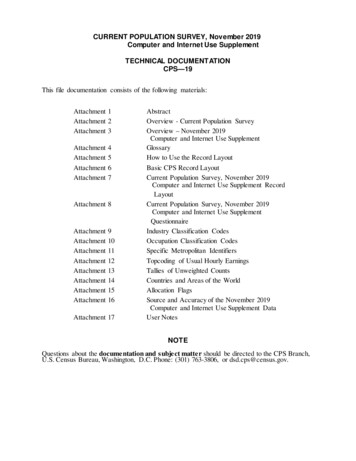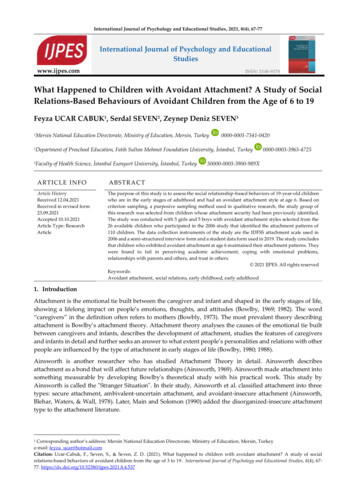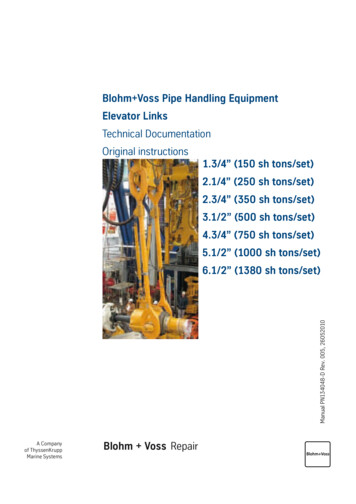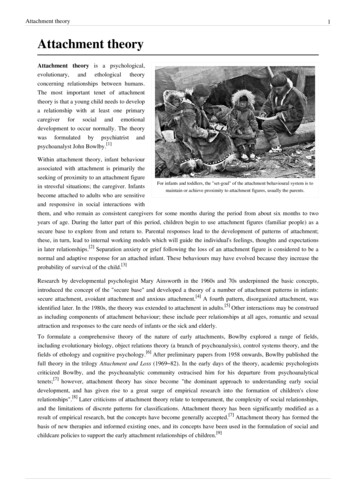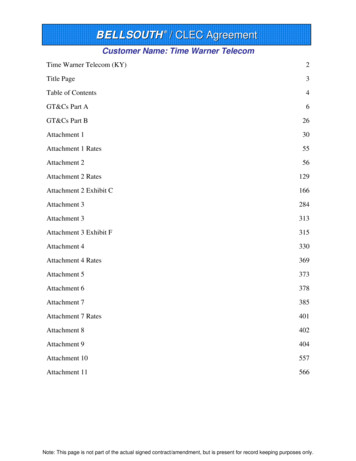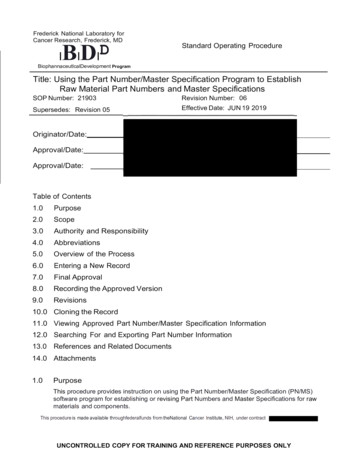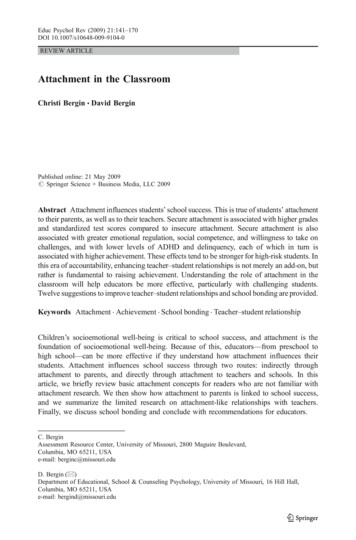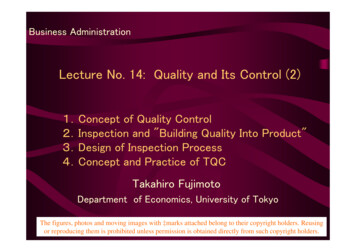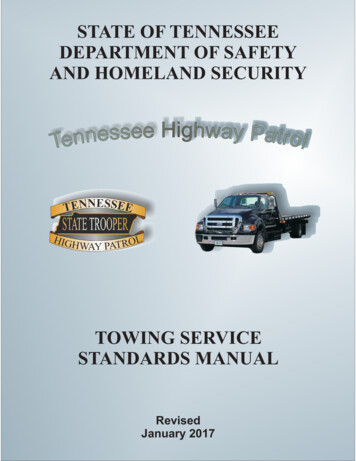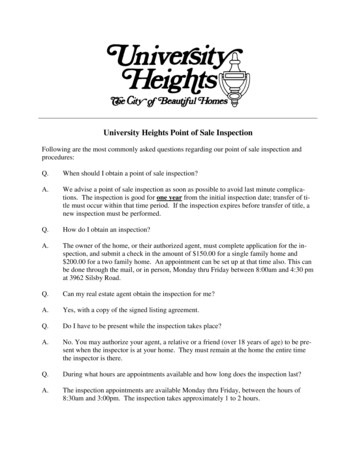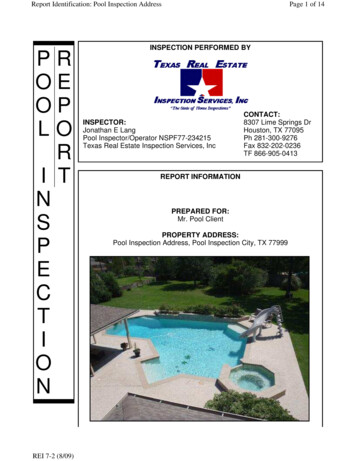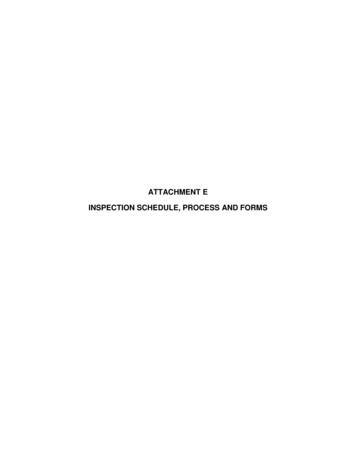
Transcription
ATTACHMENT EINSPECTION SCHEDULE, PROCESS AND FORMS
Waste Isolation Pilot PlantHazardous Waste PermitMarch 2018December 2017(This page intentionally blank)
Waste Isolation Pilot PlantHazardous Waste PermitMarch 2018December 2017ATTACHMENT EINSPECTION SCHEDULE, PROCESS AND FORMSTABLE OF CONTENTSIntroduction .1E-1Inspection Schedule .1E-1a General Inspection Requirements .3E-1a(1)Types of Problems .4E-1a(2)Frequency of Inspections .4E-1a(3)Monitoring Systems .4E-1b Specific Process Inspection Requirements .4E-1b(1)Container Inspection .4E-1b(2)Miscellaneous Unit Inspection .6References .6PERMIT ATTACHMENT EPage E-i
Waste Isolation Pilot PlantHazardous Waste PermitMarch 2018December 2017LIST OF FIGURESFigureFigure E-1Figure E-2TitleTypical Inspection ChecklistTypical Logbook EntryLIST OF TABLESTableTable E-1Table E-1aTable E-2TitleInspection Schedule/ProceduresRH TRU Mixed Waste Inspection Schedule/ProceduresMonitoring SchedulePERMIT ATTACHMENT EPage E-ii
Waste Isolation Pilot PlantHazardous Waste PermitMarch 2018December 2017ATTACHMENT EINSPECTION SCHEDULE, PROCESS AND FORMSIntroductionThis Permit Attachment describes the facility inspections (including container inspections) thatare conducted to detect malfunctions, deterioration, operator errors, and discharges that maycause or lead to releases of hazardous waste or hazardous waste constituents to theenvironment or that could be a threat to human health.E-1Inspection ScheduleEquipment instrumental in preventing, detecting, or responding to environmental or humanhealth hazards, such as monitoring equipment, safety and emergency equipment, securitydevices, and operating or structural equipment are inspected. The equipment will be inspectedfor malfunctions, deterioration, potential for operator errors, and discharges which could lead toa release of hazardous waste constituents to the environment or pose a threat to human health.The WIPP facility has developed and will maintain a series of written procedures that include allthe detailed inspection procedures and forms necessary to comply with 20.4.1.500 NMAC(incorporating 40 CFR §264.15(b)), during the Disposal Phase. Tables E-1 and E-1a list eachitem or system requiring inspection under these regulations, the inspection frequency, theorganization responsible for the inspection, the applicable inspection procedure, and what tolook for during the inspection. 20.4.1.500 NMAC (incorporating 40 CFR §§264.15(b), 264.174,and 264.602) list requirements that are applicable to the WIPP facility. Attachment D, Table D-2,Emergency Equipment Maintained at the Waste Isolation Pilot Plant, identifies the emergencyequipment and corresponding locations to be inspected in accordance with Table E-1.Operational procedures detailing the inspections required under 20.4.1.500 NMAC(incorporating 40 CFR §§264.15(a) and (b)), are maintained in electronic format on the WIPPcomputer network, in the Operating Record and, as appropriate, in controlled documentlocations at the WIPP facility. Frequency of inspections is discussed in detail in Section E-1a(2).Inspections are conducted often enough to identify problems in time to correct them before theypose a threat to human health or the environment and are based on regulatory requirements.The operational procedures assign responsibility for conducting the inspection, the frequency ofeach inspection, the types of problems to be watched for, what to do if items fail inspection,directions on record keeping, and inspector signature, date, and time. The operationalprocedures are maintained at the WIPP facility. Tables E-1 and E-1a summarize inspections,frequencies, responsible organizations, personnel making the inspection (by job title), and thetypes of anticipated problems as well as the references for the operational procedures.Inspection records are maintained at the WIPP site for three years. Beginning with the effectivedate of this Permit, records that are over the three year retention period are either maintained atthe WIPP site or transferred to the WIPP Records Archive located in Carlsbad, NM until closure.The records maintained at the WIPP Records Archive are stored in facilities that aretemperature and humidity controlled especially for the long term storage of records and readilyretrievable and available for inspection.PERMIT ATTACHMENT EPage E-1 of 27
Waste Isolation Pilot PlantHazardous Waste PermitMarch 2018December 2017Waste handling equipment and area inspections are typically controlled through establishedprocedures and the results are recorded in logbooks or on data sheets. Operators are trained toconsult the logbook to identify the status of any piece of waste handling equipment prior to itsuse. Once a piece of equipment is identified to be operable, a preoperational inspection isinitiated in accordance with the appropriate inspection procedure in Tables E-1, E-1a, or inoperational procedures. Inspection results as described below are entered in the applicablelogbook.Inspections include identifying malfunctions or deteriorating equipment and structures.Inspection results and data, including deficiencies, discrepancies, or needed repairs arerecorded. A negative inspection result does not necessarily lead to a repair. A deficiency, suchas low fluid level, may be corrected by the inspector immediately. A discrepancy, such as anincreasing trend of a data point, may necessitate additional inspection prior to the nextscheduled frequency. The actions taken (corrected, additional inspection, or Action Request(AR) for repair submitted) are recorded on the inspection form, the WIPP automatedMaintenance Management tracking program (CHAMPS) work order sheet, or the equipmentlogbook, whichever is applicable.Items that are operational with restrictions are operated in accordance with applicablecompensatory measures. Items that are not operational are scheduled for repair or replacementin accordance with work authorization procedures. In such cases, compensatory measures maybe needed until the equipment is returned to service. These compensatory measures willprovide an equivalent level of protection, be documented in WIPP facility files (e.g., equipmentlogbook), and include an appropriate inspection schedule, when applicable.Normally, the individual inspecting the equipment/system is not qualified to make repairs andconsequently, prepares an AR if repairs are needed. The AR is tracked by the CHAMPS systemthrough the work control process. When parts are received and work instructions are completed,the work order can be scheduled. The schedule is discussed daily to ensure facilityconfiguration can support scheduled work items and to allocate and coordinate the resourcesnecessary to complete the items.Work orders are released for work by the responsible organization. When repairs are completethe responsible organization tests the equipment to ensure the repairs corrected the problem,then closes out the work order, to return the equipment to an operational status for normaloperations to resume. Implementation of these procedures constitutes compliance with20.4.1.500 NMAC (incorporating 40 CFR §264.15(c)).Requirements of 20.4.1.500 NMAC (incorporating 40 CFR §264.15(d)), are met by theinspections for each item or system included in Tables E-1 and E-1a. Beginning with theeffective date of this Permit, the results of the inspections are maintained in the operating recordfor three years and are then transferred to the WIPP Records Archive where they aremaintained until closure. The inspection logs or summary records include the date and time ofinspection, the name of the inspector, a notation of the observations made, and the date andnature of any repairs or other remedial actions. Major pieces of waste handling equipment areinspected using proceduralized inspections. Current copies of inspection forms are maintainedin the Operating Record. Non-administrative changes (i.e., changes that affect the frequency orcontent of inspections) to inspection forms must be submitted to the NMED in accordance withthe appropriate portions of 20 NMAC 4.1.900 (incorporating 40 CFR §270.42). The status ofthese pieces of equipment is maintained in an equipment logbook that is separate from thePERMIT ATTACHMENT EPage E-2 of 27
Waste Isolation Pilot PlantHazardous Waste PermitMarch 2018December 2017checklist. The logbook contains information regarding the condition of the equipment.Equipment operators are required, by the inspection checklist, to consult the logbook as the firstactivity in the inspection procedure. This logbook is maintained in the operating record. CHtransuranic (TRU) mixed waste equipment that is controlled by a logbook includes the wastehandling forklifts, all waste handling cranes, the adjustable center of gravity lift fixture, the CHTRU underground transporter, the facility transfer vehicle, the trailer jockey, and the push-pullattachment. RH TRU mixed waste equipment that is controlled by a logbook includes the140/25-ton RH Bay overhead bridge crane, cask transfer cars, 25-ton cask unloading roomcrane, transfer cell shuttle car, RH Bay cask lifting yoke, facility grapple, 6.2- ton overhead hoist,facility cask rotating device, hot cell overhead powered manipulator, 15-ton hot cell crane,facility cask transfer car, 41-ton forklift, facility cask, and emplacement equipment. Inspectionsof the Cask Unloading Room, Hot Cell, Transfer Cell, Facility Cask Loading Room, RH Bay andradiation monitoring equipment will be recorded on data sheets. In addition to the inspectionslisted in Tables E-1 and E-1a, many pieces of equipment are subject to regular preventivemaintenance. This includes more in-depth inspections of mechanical systems, load testing oflifting systems, calibration of measurement equipment and other actions as recommended bythe equipment manufacturer or as required by DOE Orders. These preventive maintenanceactivities along with the inspections in Tables E-1 and E-1a make mechanical failure of wastehandling equipment unlikely. The WIPP Safety Analysis Report (DOE, 1999) and the WIPPRemote-Handled Waste Preliminary Safety Analysis Report (RH PSAR) (DOE, 2000) containthe results of a systematic analysis of waste handling equipment and the hazards associatedwith potential mechanical failures. Equipment subject to failures that cannot practically bemitigated is retained for analysis and is the basis for contingency planning. The inspectionprocedures maintained in the Operating Record for operational and preventive maintenance areimplemented to assure the equipment is maintained. An example equipment inspectionchecklist and a typical logbook form are shown as Figures E-1 and E-2. Actual checklists orforms are maintained within the Operating Record.E-1aGeneral Inspection RequirementsTables E-1, E-1a, and E-2 of this Permit Attachment list the major categories of monitoringequipment, safety and emergency systems, security devices, and operating and structuralequipment that are important to the prevention or detection of, or the response to,environmental or human health hazards caused by hazardous waste. These systems mayinclude numerous subsystems. These systems are inspected according to the frequency listedin Tables E-1 and E-1a, a copy of which is maintained at the WIPP facility. The frequency ofinspections is based on the nature of the equipment or the hazard and regulatory requirements.When in use, daily inspections are made of areas subject to spills, such as TRU mixed wasteloading and unloading areas in the WHB Unit, looking for deterioration in structures, mechanicalitems, floor coatings, equipment, malfunctions, etc., in accordance with 20.4.1.500 NMAC(incorporating 40 CFR §264.15(b)(4)).As required in 20.4.1.500 NMAC (incorporating 40 CFR §264.33), the WIPP facility inspectionprocedures for communication and alarm systems, fire-protection equipment, and spill controland decontamination equipment include provisions for testing and maintenance to ensure thatthe equipment will be operable in an emergency.PERMIT ATTACHMENT EPage E-3 of 27
Waste Isolation Pilot PlantHazardous Waste PermitMarch 2018December 2017E-1a(1)Types of ProblemsThe inspections for the systems, equipment, structures, etc., listed in Tables E-1 and E-1a,include the types of problems (e.g., malfunctions, visible cracks in coatings or welds, anddeterioration) to be looked for during the inspection of each item or system, if applicable, andare in compliance with 20.4.1.500 NMAC (incorporating 40 CFR §264.15(b)(3)).E-1a(2)Frequency of InspectionsTables E-1, E-1a, and E-2 of this Permit Attachment list the inspection frequencies andmonitoring schedule for equipment and systems subject to the 20.4.1 NMAC hazardous wastemanagement requirements. The frequency is based on the rate of possible deterioration of theequipment and the probability of an environmental or human health incident if the deteriorationor malfunction, or any operator error, goes undetected between inspections. Areas subject tospills, such as loading and unloading areas, are inspected daily when in use, consistent with therequirements of 20.4.1.500 NMAC (incorporating 40 CFR §264.15(b)(4)).When RH TRU mixed waste is present in the RH Complex, inspections are conducted visuallyand/or using closed-circuit video cameras in order to manage worker dose and to minimizeoccupational radiation exposures to as low as reasonably achievable (ALARA). More extensiveinspections of these areas are performed at least annually during routine maintenance periodsand when RH TRU mixed waste is not present.E-1a(3)Monitoring SystemsThere are two monitoring systems used at the WIPP to provide assurance that facility systemsare operating correctly, that areas can be used safely, and that there have been no releases ofhazardous waste constituents. These systems are shown in Table E-2 and include thegeomechanical monitoring system and the central monitoring system (CMS). Thegeomechanical monitoring system is used to assess the condition of mined excavations toassure no unsafe conditions are allowed to develop. The CMS continuously assesses the statusof the fixed radiation monitoring equipment, electrical power, fire alarm systems, ventilationsystem, and other facility systems including water tank levels. In addition, the CMS collects datafrom the meteorological monitoring system.E-1bSpecific Process Inspection Requirements20.4.1.500 NMAC (incorporating 40 CFR §264.15(b)(4)), requires inspections of specificportions of a facility, rather than the general facility. These include container storage areas andmiscellaneous units. Both are addressed below.E-1b(1)Container InspectionContainers are used to manage TRU mixed waste at the WIPP facility. These containers aredescribed in Permit Part 3. Off-site waste that will be managed and stored as CH TRU mixedwaste will arrive in 55-gallon drums arranged as seven (7)-packs, in Ten Drum Overpacks(TDOP), in 85-gallon drums arranged as four (4) packs, in 100-gallon drums arranged as three(3) packs, in standard waste boxes (SWB), in standard large box 2s (SLB2s) or shieldedcontainers as (3)-packs. The waste containers will be visually inspected to ensure that thewaste containers are in good condition and that there are no signs that a release has occurred.PERMIT ATTACHMENT EPage E-4 of 27
Waste Isolation Pilot PlantHazardous Waste PermitMarch 2018December 2017This visual inspection shall not include the center drums of 7-packs and waste containerspositioned such that visual observation is precluded due to the arrangement of wasteassemblies on the facility pallets. If CH TRU mixed waste handling operations should stop forany reason with containers located on the TRUPACT-II Unloading Dock (TRUDOCK storagearea of the WHB Unit) or in room 108 while still in the Contact-Handled Packages, primarywaste container inspections could not be accomplished until the containers of waste areremoved from the shipping containers.As described in Permit Attachment A1, Section A1-1d(3), off-site waste that will be managedand stored as RH TRU mixed waste will arrive in containers inside Nuclear RegulatoryCommission (NRC)-certified casks designed to provide shielding and facilitate safe handling.Canisters, will be loaded singly into an RH-TRU 72-B cask. Drums will be loaded into a CNS 10160B cask. The cask will be visually inspected upon arrival. Because RH TRU mixed waste isstored in the Parking Area Unit in sealed casks, there are no additional requirements forengineered secondary containment systems. Following removal of the canisters and drums, theinterior of the cask will be inspected and surveyed for evidence of contamination that may haveoccurred during transport.Off-site waste that will be managed and stored as RH TRU mixed waste is managed and storedin the RH Complex of the WHB. The RH Complex includes the following: RH Bay, the CaskUnloading Room, the Hot Cell, the Transfer Cell, and the Facility Cask Loading Room. As RHTRU mixed waste is held in canisters within a canister rack the physical inspection of the drumor canister is not possible. Inspections of RH TRU mixed waste in these areas occurs remotelyvia closed-circuit cameras a minimum of once weekly when stored waste is present. BecauseRH TRU mixed waste is in sealed casks, there are no additional requirements for engineeredsecondary containment systems. However, the floors in the RH Complex (including the RH Bay,Facility Cask Loading Room and Cask Unloading Room) are coated concrete and during normaloperations (i.e., when waste is present), the floor of the RH Complex is inspected visually or byusing close-circuit cameras on a weekly basis to verify that it is in good condition and free ofvisible cracks and gaps.Inspections of RH TRU mixed waste containers stored in the Hot Cell and Transfer Cell areconducted using remotely operated cameras. RH TRU mixed waste in the Hot Cell is stored ineither drums or canisters. The containers in the Hot Cell are inspected to ensure that they are inacceptable condition. RH TRU mixed waste in the Transfer Cell is stored in the RH-TRU 72-Bcask or shielded insert; therefore, inspections in this area focus on the integrity of the cask orshielded insert. RH TRU mixed waste in the Facility Cask Loading Room is stored in the facilitycask; therefore, inspections in this area focus on the integrity of the facility cask.Inspections will be conducted in the Parking Area Unit at a frequency not less than once weeklywhen waste is present. These inspections are applicable to loaded Contact- Handled andRemote-Handled Packages. The perimeter fence located at the lateral limit of the Parking AreaUnit, coupled with personnel access restrictions into the WHB Unit, will provide the neededsecurity. The perimeter fence and the southern border of the WHB shall mark the lateral limit ofthe Parking Area Unit. Radiologically controlled areas can be established temporarily withbarricades. More permanent structures can be installed. The western boundary can beestablished with temporary barricades since this area is within the perimeter fence. Access toradiologically controlled areas will only be permitted to personnel who have completed GeneralEmployee Radiological Training (GERT), a program defined by the Permittees, or escorted bypersonnel who have completed GERT. This program ensures that personnel have adequatePERMIT ATTACHMENT EPage E-5 of 27
Waste Isolation Pilot PlantHazardous Waste PermitMarch 2018December 2017knowledge to understand radiological posting they may encounter at the WIPP site. The fenceof the Radiologically Controlled Area, south from the WHB airlocks, was moved to provide moremaneuvering space for the trucks delivering waste. Since TRU mixed waste to be stored in theParking Area Unit will be in sealed Contact-Handled or Remote-Handled Packages, there will beno additional requirements for engineered secondary containment systems. Inspections of theContact-Handled and Remote-Handled Packages stored in the Parking Area Unit shall beconducted at a frequency no less than once weekly and will focus on the inventory and integrityof the shipping containers and the spacing between trailers carrying the Contact-Handled orRemote-Handled Packages. This spacing will be maintained at a minimum of four feet.Container inspections will be included as part of the surface TRU mixed waste handling areas(i.e. Parking Area Unit and WHB Unit) inspections described in Tables E-1 and E-1a. Theseinspections will also include the Derived Waste Storage Areas of the WHB Unit. The DerivedWaste Storage Areas will consist of containers of 55 or 85-gallon drums or SWBs for CH TRUmixed waste and 55-gallon drums for RH TRU mixed waste. A Satellite accumulation area(SAA) may be required in an area adjacent to the TRUDOCKs for CH TRU mixed waste. A SAAmay also be required in the RH Bay and Hot Cell for RH TRU mixed waste. These SAAs will beset up on an as needed basis at or near the point of generation and the derived waste will bediscarded into the active derived waste container. All SAAs will be inspected in accordance with20.4.1.300 NMAC (incorporating 40 CFR §262.34).E-1b(2)Miscellaneous Unit Inspection20.4.1.500 NMAC (incorporating 40 CFR §264.602), requires that inspections required in20.4.1.500 NMAC (incorporating 40 CFR §264.15 and §264.33), as well as any additionalrequirements needed to protect human health and the environment, be met. The requirementsof 20.4.1.500 NMAC (incorporating 40 CFR §264.15 and §264.33) are discussed in Section E-1of this Permit Attachment, along with how the WIPP facility complies with those requirements forstandard types of inspections. Inspection frequencies for geomechanical monitoring equipmentare provided in Table E-1. The monitoring schedule for geomechanical instrumentation is givenin Table E-2.ReferencesDOE, 1999. “WIPP Safety Analysis Report,” DOE/WIPP-95-2065. Rev. 4, U.S. Department ofEnergy. Washington, D.C.DOE, 2000. “WIPP Remote-Handled Waste Preliminary Safety Analysis” (RH PSAR), U.S.Department of Energy. Washington, D.C.PERMIT ATTACHMENT EPage E-6 of 27
Waste Isolation Pilot PlantHazardous Waste PermitMarch 2018December 2017FIGURESPERMIT ATTACHMENT EPage E-7 of 27
Waste Isolation Pilot PlantHazardous Waste PermitMarch 2018December 2017(This page intentionally blank)PERMIT ATTACHMENT EPage E-8 of 27
Waste Isolation Pilot PlantHazardous Waste PermitMarch 2018December 2017Figure E-1Typical Inspection ChecklistPERMIT ATTACHMENT EPage E-9 of 27
Waste Isolation Pilot PlantHazardous Waste PermitMarch 2018December 2017Figure E-2Typical Logbook EntryPERMIT ATTACHMENT EPage E-10 of 27
Waste Isolation Pilot PlantHazardous Waste PermitMarch 2018December 2017TABLESPERMIT ATTACHMENT EPage E-11 of 27
Waste Isolation Pilot PlantHazardous Waste PermitMarch 2018December 2017(This page intentionally blank)PERMIT ATTACHMENT EPage E-12 of 27
Waste Isolation Pilot PlantHazardous Waste PermitMarch 2018December 2017Table E-1Inspection OrganizationInspectionaFrequency and Job Titleof Personnel NormallyMaking InspectionProcedure Number andInspection CriteriahAir Intake Shaft HoistUndergroundOperationsPreoperational cSee Lists 1b and cWP 04-HO1004Inspecting for Deteriorationb,Safety Equipment,Communication Systems, andMechanical Operabilitym inaccordance with Mine Safetyand Health Administration(MSHA) requirementsAmbulance (Surface) andMedical Cart(Underground)Fire DepartmentWeeklySee List 11WP 12-FP0030Inspecting for MechanicalOperabilitym, Deteriorationb, andRequired EquipmentnAdjustable Center ofGravity Lift FixtureWaste HandlingPreoperational cSee List 8WP 05-WH1410Inspecting for MechanicalOperabilitym and DeteriorationbBackup Power SupplyDiesel GeneratorsFacility OperationsMonthlySee List 3WP 04-ED1301Inspecting for MechanicalOperabilitym and Leaks/Spills bystarting and operating bothgenerators. Results of thisinspection are logged inaccordance with WP 04AD3008.Facility Inspections (WaterDiversion Berms)Facility EngineeringAnnuallySee List 4WP 10-WC3008Inspecting for Damage,Impediments to water flow, andDeteriorationbCentral MonitoringSystems (CMS)Facility OperationsContinuousSee List 3Automatic Self-CheckingContact-Handled (CH)TRU UndergroundTransporterWaste HandlingPreoperational cSee List 8WP 05-WH1603Inspecting for Leaks/Spills,Mechanical Operabilitym,Deteriorationb, and area aroundtransporter clear of obstaclesConveyance Loading CarWaste HandlingPreoperational cSee List 8WP 05-WH1406Inspecting for MechanicalOperabilitym, Deteriorationb, pathclear of obstacles, and guards inthe proper placeFacility Transfer VehicleWaste HandlingPreoperational cSee List 8WP 05-WH1204Inspecting for MechanicalOperabilitym, Deteriorationb, pathclear of obstacles, and guards inthe proper placePERMIT ATTACHMENT EPage E-13 of 27
Waste Isolation Pilot PlantHazardous Waste PermitMarch 2018December pectionaFrequency and Job Titleof Personnel NormallyMaking InspectionProcedure Number andInspection CriteriahEmergency LightingFire DepartmentMonthly/annuallySee List 11WP 12-FP0051Inspecting for Deteriorationb,and Operability of indicator lightsin accordance with NFPA 101Exhaust ShaftUndergroundOperationsQuarterlySee List 1aPM041099Inspecting for Deteriorationb andLeaks/SpillsEye Wash and ShowerEquipmentEquipmentCustodianWeeklySee List 5WP 12-IS1832Inspecting for DeteriorationbSemi-annuallySee List 2aWP 12-IS1832Inspecting for Deteriorationb andFluid Levels–Replace asRequiredSemi-annually/annuallySee List 12WP 12-FP0027Inspecting for Deteriorationb andOperability of underground fuelstation fire suppression systemin accordance with NFPA 17(semi-annual inspection);Inspecting for Deteriorationb andOperability of the alarm paneland transmitter, audible/visualalarm devices, detectors, andpull stations in accordance withNFPA 72 (annual inspection)WP 12-FP0028Inspecting for Deteriorationb,and Operability of the alarmpanel and transmitter,audible/visual alarm devices,detectors, and pull stations inaccordance with NFPA 72Fire Detection and AlarmSystemFire ProtectionEngineeringMonthly/quarterly/annuallySee List 12Fire ExtinguishersjFire DepartmentMonthlySee List 11WP 12-FP0036Inspecting for Deteriorationb,Leaks/Spills, Expiration, seals,fullness, and pressureFire HosesFire DepartmentAnnually (minimum)See List 11WP 12-FP0031Inspecting for Deteriorationb andLeaks/SpillsFire HydrantsFire ProtectionEngineeringSemi-annual/annuallySee List 12WP 12-FP0034Inspecting for Deteriorationb andLeaks/SpillsPERMIT ATTACHMENT EPage E-14 of 27
Waste Isolation Pilot PlantHazardous Waste PermitMarch 2018December 2017System/EquipmentNameFire PumpsResponsibleOrganizationFire ProtectionEngineeringInspectionaFrequency and Job Titleof Personnel NormallyMaking InspectionProcedure Number andInspection CriteriahWeeklySee List 12WP 12-FP0026Inspecting for Deteriorationb,Leaks/Spills, fire water valveposition(s), and panel lightstatusAnnually (Electric Pump)See List 12WP 12-FP5113Inspecting for Deteriorationb,operability, flow, dischargepressure, suction pressure, andpump speedAnnually (Diesel Pump)See List 12WP 12-FP5114Inspecting for Deteriorationb,operability, flow, dischargepressure, suction pressure, andpump speedFire Sprinkler SystemsFire ProtectionEngineeringMonthly/quarterly/ annuallySee List 12WP 12-FP0025, WP 12-FP0063,and WP 12-FP0064Inspecting for Deteriorationb,Leaks/Spills, water pressures,and main drain testFire and EmergencyResponse Vehicles (FireTrucks, Fire SuppressionCart, and RescueCart/Truck)Fire DepartmentWeeklySee List 11WP 12-FP0033Inspecting for MechanicalOperabilitym, Deteriorationb,Leaks/Spills, and RequiredEquipmentnForklifts Used for WasteHandling (Electric andDiesel forklifts, Push-PullAttachment)Waste HandlingPreoperational cSee List 8WP 05-WH1201, WP 05WH1207, WP 05-WH1401, WP05-WH1402, WP 05-WH1403,and WP 05-WH1412Inspecting for Leaks/Spills,Mechanical Operabilitym,Deteriorationb, and On board firesuppression systemAutomatic on-board firesuppression systemsFire ProtectionEngineeringMonthly/Semi-annuallySee List 12WP 12-FP0085WP 12-FP0060Inspecting for MechanicalOperabilitym and DeteriorationbHazardous MaterialResponse EquipmentFire DepartmentQuarterly See List 11WP 12-FP0033Inspecting for Deteriorationb,and Required EquipmentnHead LampsFacility PersonnelDailyiHead lamps are operated dailyand are repaired or replacedupon failurePERMIT ATTACHMENT EPage E-15 of 27
Waste Isolation Pilot PlantHazardous Waste PermitMarch 2018December pectionaFrequency and Job Titleof Personnel NormallyMaking InspectionProcedure Number andInspection CriteriahMiners First Aid StationFire DepartmentQuarterlySee List 11WP 12-FP0035Inspecting for RequiredEquipmentnMobile PhonesFacility PersonnelDailyiMobile Phones are operateddaily and are repaired orreplaced upon failureMine Pager Phones(between surface andunderground)Facility OperationsMonthly/AnnuallyoSee List 3WP 04-PC3017WP 04-PC3018Testing
As required in 20.4.1.500 NMAC (incorporating 40 CFR §264.33), the WIPP facility inspection procedures for communication and alarm systems, fire- protection equipment, and spill control and decontamination equipment include provisions for testing and maintenance to ensure that the equipment will be operable in an emergency.
